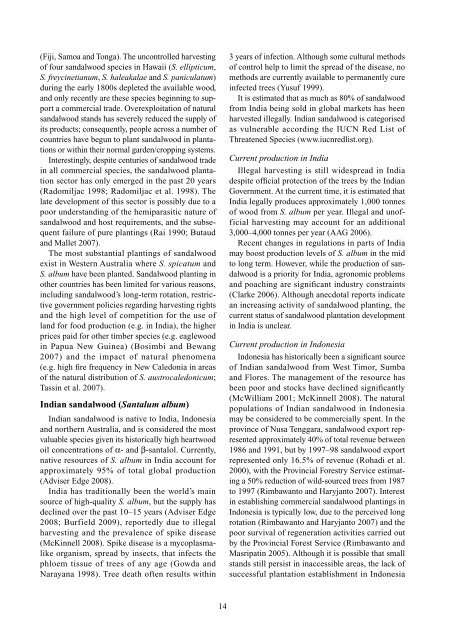Opportunities for the smallholder sandalwood industry in ... - ACIAR
Opportunities for the smallholder sandalwood industry in ... - ACIAR
Opportunities for the smallholder sandalwood industry in ... - ACIAR
You also want an ePaper? Increase the reach of your titles
YUMPU automatically turns print PDFs into web optimized ePapers that Google loves.
(Fiji, Samoa and Tonga). The uncontrolled harvest<strong>in</strong>g<br />
of four <strong>sandalwood</strong> species <strong>in</strong> Hawaii (S. ellipticum,<br />
S. freyc<strong>in</strong>etianum, S. haleakalae and S. paniculatum)<br />
dur<strong>in</strong>g <strong>the</strong> early 1800s depleted <strong>the</strong> available wood,<br />
and only recently are <strong>the</strong>se species beg<strong>in</strong>n<strong>in</strong>g to support<br />
a commercial trade. Overexploitation of natural<br />
<strong>sandalwood</strong> stands has severely reduced <strong>the</strong> supply of<br />
its products; consequently, people across a number of<br />
countries have begun to plant <strong>sandalwood</strong> <strong>in</strong> plantations<br />
or with<strong>in</strong> <strong>the</strong>ir normal garden/cropp<strong>in</strong>g systems.<br />
Interest<strong>in</strong>gly, despite centuries of <strong>sandalwood</strong> trade<br />
<strong>in</strong> all commercial species, <strong>the</strong> <strong>sandalwood</strong> plantation<br />
sector has only emerged <strong>in</strong> <strong>the</strong> past 20 years<br />
(Radomiljac 1998; Radomiljac et al. 1998). The<br />
late development of this sector is possibly due to a<br />
poor understand<strong>in</strong>g of <strong>the</strong> hemiparasitic nature of<br />
<strong>sandalwood</strong> and host requirements, and <strong>the</strong> subsequent<br />
failure of pure plant<strong>in</strong>gs (Rai 1990; Butaud<br />
and Mallet 2007).<br />
The most substantial plant<strong>in</strong>gs of <strong>sandalwood</strong><br />
exist <strong>in</strong> Western Australia where S. spicatum and<br />
S. album have been planted. Sandalwood plant<strong>in</strong>g <strong>in</strong><br />
o<strong>the</strong>r countries has been limited <strong>for</strong> various reasons,<br />
<strong>in</strong>clud<strong>in</strong>g <strong>sandalwood</strong>’s long-term rotation, restrictive<br />
government policies regard<strong>in</strong>g harvest<strong>in</strong>g rights<br />
and <strong>the</strong> high level of competition <strong>for</strong> <strong>the</strong> use of<br />
land <strong>for</strong> food production (e.g. <strong>in</strong> India), <strong>the</strong> higher<br />
prices paid <strong>for</strong> o<strong>the</strong>r timber species (e.g. eaglewood<br />
<strong>in</strong> Papua New Gu<strong>in</strong>ea) (Bosimbi and Bewang<br />
2007) and <strong>the</strong> impact of natural phenomena<br />
(e.g. high fire frequency <strong>in</strong> New Caledonia <strong>in</strong> areas<br />
of <strong>the</strong> natural distribution of S. austrocaledonicum;<br />
Tass<strong>in</strong> et al. 2007).<br />
Indian <strong>sandalwood</strong> (Santalum album)<br />
Indian <strong>sandalwood</strong> is native to India, Indonesia<br />
and nor<strong>the</strong>rn Australia, and is considered <strong>the</strong> most<br />
valuable species given its historically high heartwood<br />
oil concentrations of α- and β-santalol. Currently,<br />
native resources of S. album <strong>in</strong> India account <strong>for</strong><br />
approximately 95% of total global production<br />
(Adviser Edge 2008).<br />
India has traditionally been <strong>the</strong> world’s ma<strong>in</strong><br />
source of high-quality S. album, but <strong>the</strong> supply has<br />
decl<strong>in</strong>ed over <strong>the</strong> past 10–15 years (Adviser Edge<br />
2008; Burfield 2009), reportedly due to illegal<br />
harvest<strong>in</strong>g and <strong>the</strong> prevalence of spike disease<br />
(McK<strong>in</strong>nell 2008). Spike disease is a mycoplasmalike<br />
organism, spread by <strong>in</strong>sects, that <strong>in</strong>fects <strong>the</strong><br />
phloem tissue of trees of any age (Gowda and<br />
Narayana 1998). Tree death often results with<strong>in</strong><br />
3 years of <strong>in</strong>fection. Although some cultural methods<br />
of control help to limit <strong>the</strong> spread of <strong>the</strong> disease, no<br />
methods are currently available to permanently cure<br />
<strong>in</strong>fected trees (Yusuf 1999).<br />
It is estimated that as much as 80% of <strong>sandalwood</strong><br />
from India be<strong>in</strong>g sold <strong>in</strong> global markets has been<br />
harvested illegally. Indian <strong>sandalwood</strong> is categorised<br />
as vulnerable accord<strong>in</strong>g <strong>the</strong> IUCN Red List of<br />
Threatened Species (www.iucnredlist.org).<br />
Current production <strong>in</strong> India<br />
Illegal harvest<strong>in</strong>g is still widespread <strong>in</strong> India<br />
despite official protection of <strong>the</strong> trees by <strong>the</strong> Indian<br />
Government. At <strong>the</strong> current time, it is estimated that<br />
India legally produces approximately 1,000 tonnes<br />
of wood from S. album per year. Illegal and unofficial<br />
harvest<strong>in</strong>g may account <strong>for</strong> an additional<br />
3,000–4,000 tonnes per year (AAG 2006).<br />
Recent changes <strong>in</strong> regulations <strong>in</strong> parts of India<br />
may boost production levels of S. album <strong>in</strong> <strong>the</strong> mid<br />
to long term. However, while <strong>the</strong> production of <strong>sandalwood</strong><br />
is a priority <strong>for</strong> India, agronomic problems<br />
and poach<strong>in</strong>g are significant <strong><strong>in</strong>dustry</strong> constra<strong>in</strong>ts<br />
(Clarke 2006). Although anecdotal reports <strong>in</strong>dicate<br />
an <strong>in</strong>creas<strong>in</strong>g activity of <strong>sandalwood</strong> plant<strong>in</strong>g, <strong>the</strong><br />
current status of <strong>sandalwood</strong> plantation development<br />
<strong>in</strong> India is unclear.<br />
Current production <strong>in</strong> Indonesia<br />
Indonesia has historically been a significant source<br />
of Indian <strong>sandalwood</strong> from West Timor, Sumba<br />
and Flores. The management of <strong>the</strong> resource has<br />
been poor and stocks have decl<strong>in</strong>ed significantly<br />
(McWilliam 2001; McK<strong>in</strong>nell 2008). The natural<br />
populations of Indian <strong>sandalwood</strong> <strong>in</strong> Indonesia<br />
may be considered to be commercially spent. In <strong>the</strong><br />
prov<strong>in</strong>ce of Nusa Tenggara, <strong>sandalwood</strong> export represented<br />
approximately 40% of total revenue between<br />
1986 and 1991, but by 1997–98 <strong>sandalwood</strong> export<br />
represented only 16.5% of revenue (Rohadi et al.<br />
2000), with <strong>the</strong> Prov<strong>in</strong>cial Forestry Service estimat<strong>in</strong>g<br />
a 50% reduction of wild-sourced trees from 1987<br />
to 1997 (Rimbawanto and Haryjanto 2007). Interest<br />
<strong>in</strong> establish<strong>in</strong>g commercial <strong>sandalwood</strong> plant<strong>in</strong>gs <strong>in</strong><br />
Indonesia is typically low, due to <strong>the</strong> perceived long<br />
rotation (Rimbawanto and Haryjanto 2007) and <strong>the</strong><br />
poor survival of regeneration activities carried out<br />
by <strong>the</strong> Prov<strong>in</strong>cial Forest Service (Rimbawanto and<br />
Masripat<strong>in</strong> 2005). Although it is possible that small<br />
stands still persist <strong>in</strong> <strong>in</strong>accessible areas, <strong>the</strong> lack of<br />
successful plantation establishment <strong>in</strong> Indonesia<br />
14
















